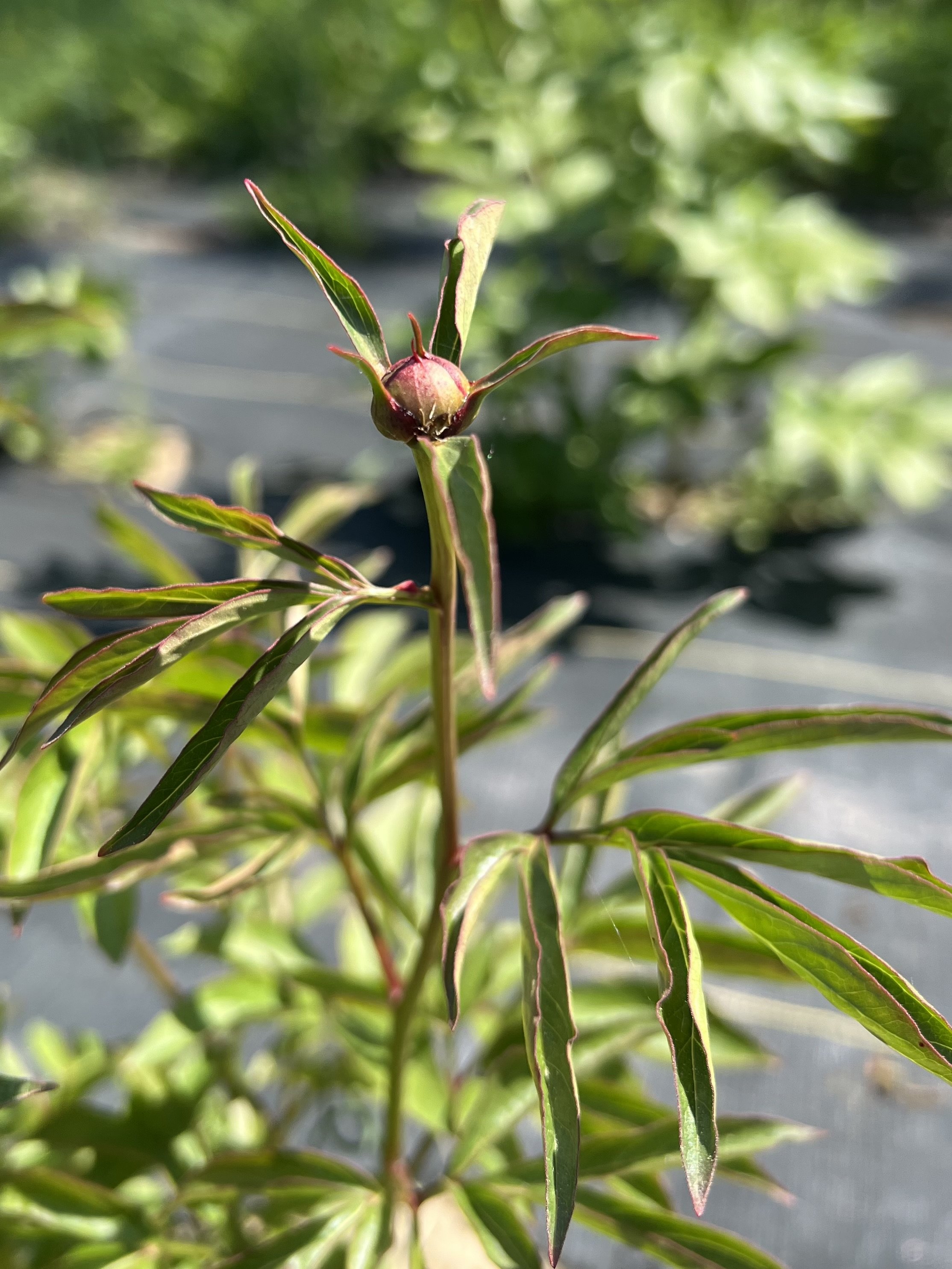How to Plant, Grow, and Care for Peonies on Your Flower Farm
I knew in the beginning, peonies would have a place at Muddy Acres Flower Farm. More than seven years later and they are one of just a handful of flowers we grow. And for good reason. Once they’re planted, they require minimal labor. They get better year after year. The demand for peonies is unmatched. They can be shipped across the country and the price per stem is very seductive. These qualities make for a dream product.
Here at Muddy Acres, I have around 3500 peonies planted. 2500 were planted in 2019, 300ish in 2022 and 600ish in 2023. I hope to add to the field every year.
The plants within each row are 2’ apart and the rows are 3’ apart.
The main field is 60’ x 270’ for the original 2500.
The field isn’t irrigated because there is no water access.
The peonies aren’t fertilized.
Where to Buy Peonies
The question I hear time and time again… “Where do you buy your…” and the season we’re in determines how the question ends. If you want to purchase 25+ of one peony variety, I put together a guide of my favorite flower farm resources, including my favorite peony wholesaler.
If you want smaller quantities and a mix of different varieties, check out the peony selection from my farm. (Btw, if you buy 3 peonies, I’ll throw in a Sarah Bernhardt peony for FREE! Coupon Code SARAH)
And if I were to preach one tip about buying peonies, it’s to buy wholesale when you can. Yes, you have to buy larger quantities, but you will pay a fraction of the price. Go in with a friend, sell off extra stock, share with another local farm. When you pay wholesale prices, you can buy a 3-5 eye peony root for less than the cost of a dahlia tuber!
Interested in more pricing? Check out Growing Peonies for Profit to help you plan out your financials.
Planting and Caring for Your Peonies
Deciding to grow peonies on your flower farm is an exciting choice. But it can be overwhelming to wrap your head around all of the tasks that come with it. It’s worth it, I promise! Let me break down the primary things to consider.
Choose the Right Location
Choosing the right location for your peonies is the first step toward success. Here are some things to keep in mind:
Sunlight: Peonies are sun-lovers and require at least 6-8 hours of direct sunlight daily for optimal growth and abundant blooms.
Soil quality: Peonies thrive in well-draining soil. Consider getting a soil test done and amending the soil with compost or organic matter to improve its quality.
Space: You will need adequate spacing between peony plants to prevent disease and reduced airflow. And to be honest, it’s likely you will want to continually add to your field or garden!
Accessibility: Consider how easily you can access your peonies for planting, maintenance, and harvesting. Convenient access saves time and effort.
Proximity to water: Access to a water source for irrigation may be a requirement for your zone.
Peony Spacing
My peonies are spaced 2’ apart while the rows are 3’ apart. If I could go back and do it over again, I would space the plants 3’ apart versus 2’, simply for better airflow. They’re packed in there!
How to Plant Peony Roots
After you’ve purchased the peony varieties you want to grow, begin by digging a hole that’s wide and deep enough to comfortably accommodate the root system. Ensure the eyes (the small, reddish buds on the root) are planted no deeper than two inches below the soil surface. This is a big one because if you plant them too deep, they may fail to produce. Once the roots are in the ground, water them thoroughly to settle the soil and eliminate air pockets.
It’s best to plant peonies in the fall, however you can also plant them in the spring. Heck, I even planted them in the heart of winter.
Fall Peony Care
After you harvest your peonies, you don’t really need to do much with your field until fall. After the first frost, all of the foliage should be dead, and you can cut back the stems to the ground.
If you choose to fertilize, now is the time to do it. However, peonies are pretty tough and won’t need too much extra help unless your soil quality is poor.
If the peonies have been in the ground for less than a year or two and you live in a cold climate with very cold winters, consider adding a very light layer of mulch for extra protection. Remove the mulch in the spring.
Should You Disbud Your Peonies?
It’s recommended to remove peony buds for three seasons so the plant can focus on root growth versus flower production.
Peonies typically take a few years to mature and develop a strong root system, and removing the buds during this time allows the plant to direct its energy towards root growth rather than flower production. This, in turn, helps establish a strong and healthy plant that can produce more blooms in the future.
So now that I’ve given general recommendations, let me tell you my honest opinion. Use your best judgment. If you have peony babies that are 8” tall and minimal leaves, obviously it’s best to remove the buds so the plant can focus on establishing its roots.
If you have new peony plants that are robust and cranking out the blooms, you may choose to cut from them like me. Just keep the stems short leaving as much foliage as possible. For the first 2 years, I moved a gazillion mini bouquets shown below allowing me to recoup 90% of the initial investment by year 2.
If you choose to disbud your peonies, do so as early as possible. If your buds are the size of a golf ball, the plant has already expended the energy required to produce the bud. You might as well let it bloom and enjoy it. The goal is to remove the buds when they are pea size or as soon as you see them to save the plant the resources it needs to produce the bud. You can see the difference below. Cut the bud sooner rather than later.
When to Harvest Peonies
You want to harvest peonies in the marshmallow stage for optimum vase life. The marshmallow stage is when the peony bud is just beginning to open, and the petals are still tightly packed together. Give the bud a gentle pinch and if it feels soft like a marshmallow, it’s time.
When harvesting peonies at this stage, the flower has the best chance of lasting a long time in a vase. After cutting, the stems should be placed in cool water and kept in a cool location out of direct sunlight. With proper care, peonies harvested in the marshmallow stage can last up to a week in a vase, providing a beautiful and long-lasting addition to any bouquet.
Dry Storing Peonies
Did you know you can hold peonies in a cooler up to 2-3 months? It’s pretty magical if you ask me!
To dry store peony stems in a cooler, harvest the peonies in the marshmallow stage. Remove any leaves or foliage from the stems, as they can cause mold or bacteria to form during storage. Arrange the peonies in a single layer wrapped in newspaper and label with the date of harvest. Place them in a cooler with a temperature between 35 and 40 degrees.
When you’re ready to use your stored peonies, remove them from their wrap, cut 1-2" off the ends of the stems, and place the flowers in water. Over the next 24 hours, the blooms will open.
How to Get Rid of Ants on Peonies
Ever heard that peonies need ants to grow? It’s a myth. Everything you’ve heard about ants and peonies is a myth. They aren’t a nuisance. They don’t harm or eat your peonies and they aren’t “tickling” the buds to encourage them to open. They’re simply enjoying the sugary sap peony buds secrete. Peonies and ants have a mutually beneficial relationship. The ants keep other pests at bay while enjoying a sugary treat.
But let’s be honest, you don’t want to bring them into your house. So how do you get them off? Give them a good flick. It’s as simple as that. Or if you have a handful, tip them upside down and give them a little shake.
At this point, this goes without saying, but I adore peonies. Not only because they're wonderfully beautiful, but because they're an absolute star on the flower farm. If you've been shying away from peonies because of the cost or the development time, I'm here to tell you, DON'T! If after reading this, you're still feeling nervous about committing, just start out with a few plants and see how things go.
If you're thinking about farming peonies for profit, be sure to check out Growing Peonies for Profit. This guide offers an in-depth look at what it takes to build a peony business and helps you determine if it's the right fit for you.
P.S. If you want to see an example profit plan for a young field of peonies, click here.
Avoid These Costly Mistakes When Starting a Flower Farm!
Learn the top five mistakes new cut flower farmers often make. By being aware of these pitfalls, you'll grow your business faster, save valuable time, and reduce unnecessary expenses. Get your copy now and take the first step towards a successful and profitable flower farm!













